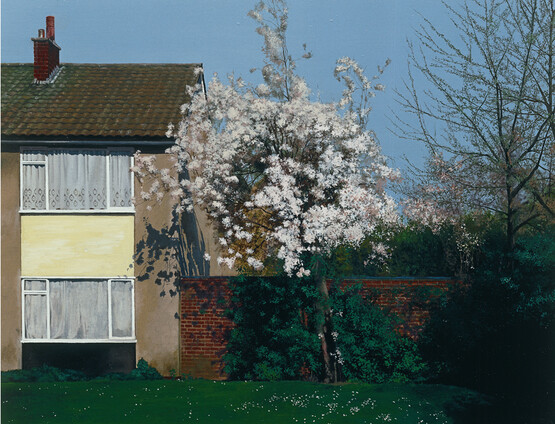
George Shaw
10.03.2019 • Reviews / Exhibition

by Isaac Nugent
Reviews /
Exhibition
• 18.03.2020
Y.Z. Kami’s series of Night Paintings – eleven large canvases currently hanging in the shuttered galleries of Gagosian, Rome – are concerned with things that, like the night, cannot be easily grasped or observed. It is not always clear what the pictures depict. Each canvas is painted in deep indigo, modified only through the addition of white, giving the impression of nightfall FIG.1. Arranged at intervals around an almond-shaped gallery space, most of the paintings fail to cohere into anything solid or readable, but seem to consist of swirling clouds of vapour. Squint and you might make something out, if only for a second. Even where the image is more legible – as in two paintings of Hindu mystic Sri Ramakrishna surrounded by his followers – a large portion of the surface is obscured by a swathe of indigo, as if it were in the process of being erased or forgotten. The ethereal, otherworldly atmosphere conjured up here runs perilously close to being an escapist fantasy, but with Kami’s deft touch, the Night Paintings possess considerable potency.
Rome, a major centre of the Christian faith since the 1st century AD, provides a challenging setting for art of a spiritual nature. Surrounded by centuries of religious art, there is a risk of contemporary responses appearing hackneyed. Nearby, Robert Morris’s posthumous installation Momentum 2015–2018 occupies the central court of La Galleria Nazionale d’Arte Moderna e Contemporanea. Shrouded figures constructed from crumpled linen cast in resin or carbon fibre are organised into animated groups, as if experiencing a kind of eschatological end-time event, or rapture. In a somewhat contrived fashion, Morris’s installation takes its cue from art history; one group of figures is posed identically to Auguste Rodin’s Burghers of Calais (1884–89) while the others imitate Francisco Goya’s drawings of witches. It is a retrograde step for an artist who revolutionised sculpture with his minimal works of the 1960s to be making such clunky allusions to the art of the past. In rehashing existing models, Morris’s installation feels like a missed opportunity to develop a new visual language for states of extreme emotion or transcendence.
Kami avoids such pastiche in his approach to the transcendental, considering this pictorial problem anew. Throughout his career, the limits of representation have preoccupied the artist. In the mid-1990s, Kami came to prominence painting large and arresting portraits that aimed to create the impression that the sitter was physically present. Inspired by the immediacy of Fayum funerary portraits, he attempted to fix the essence of the people he painted on canvas, paying close attention to the physical features that individualised them. Perhaps conceding the impossibility of achieving a true resemblance, over time his portraits became less descriptive and more abstract. In the mid-2000s, Kami began to make paintings of a different nature, depicting subjects that took no concrete form. In two parallel series entitled Domes and Endless Prayers, Kami became absorbed by the symbolic potential of sacred geometry. In the former series, regular dashes of colour are composed in mandala-like formations, inspired by sacred architecture; while the pictures in the latter consist of fragments of poetry and prayer from different religions collaged into patterns, intended to evoke the power of intense religious devotion.
Having oscillated between depicting what can be perceived through observation and touch and what can only be represented emblematically, in the Night Paintings Kami tackles the space between the two: felt and experienced but not concretely seen. Kami’s paintings of Ramakrishna, entitled The Great Swan FIG.2 and From ‘The Great Swan’ (2019), which are placed at either end of the gallery space, illustrate this liminal territory. The mystic is represented in a state of samadhi or ecstasy, where the mind becomes detached from the body and absorbed into a higher level of consciousness, beyond the material world. In both paintings the upper half of the saint’s body is shrouded in a dark fog, acting as a visual metaphor for his trance-like state, while in the blurred lower sections – derived from a photograph of one of Ramakrishna’s trances taken in 1879 – the murkiness clears, revealing a circle of onlookers and the saint’s spindly legs, blazing with light.
By merging photographic documentation with painterly flourish, Kami’s paintings of Ramakrishna illustrate the entrance of the saint’s soul to a spiritual plane. The other paintings in the exhibition use less straightforward strategies to solve this pictorial problem. The precision and certainty of Kami’s brushwork implies that these somewhat unnerving paintings are also anchored in photography, but the source image itself is degraded: zoomed in too close to make sense, sapped of colour, blurred and with the contrast set too high. From a distance, the image represented retains coherence, but as you draw closer this illusion disintegrates; you see passages of loose brushwork blended together and an uneven surface that fluctuates between shiny and matt, with flecks of hair, brush bristles and bobbles of dried paint impregnated into it. These paintings are discomforting because they seem to retain the indexical relationship with reality that the source photograph they were painted from possesses, without it being clear what is depicted. For instance, Night Painting VI FIG.3 describes the surface of something that feels familiar or organic, like the papery texture of dry leaves or a mound of irregularly shaped rocks, but Night Painting X FIG.4 seems less solid, perhaps the play of light on the surface of a body of water or a wispy cirrus cloud. The effect is subtle and becomes stronger the longer you look.
In these works, Kami has developed a novel means of depicting phenomena that it is impossible to pin down in perceptual terms. Although they are often challenging to decipher, the Night Paintings are an an affecting and poetic body of work that circle the limits of what is possible to depict in painting.